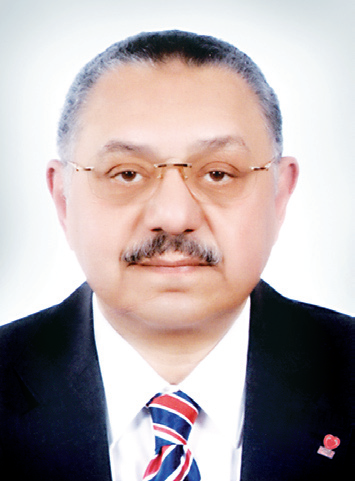Percutaneous Management of Resistant Hypertension
Percutaneous Management of Resistant Hypertension
Ahmed Kamal Motaweih
M.Sc.Medicine&Cardiology- M.D Cardioloy & Vasc.Dis
Porf.& Hed Of Cardio - Vasc.Medicine Dept
Faculty Of Medicine Azhar Univ. F.E.S.C & F.A.C.C.
■ Approximately one-third of the adult population in the developed World suffers from hypertension. It is the leading cause of mortality Worldwide; causing 7.5 million deaths annually, every 20/10 mmHg increase in blood pressure is associated with a doubling of cardio vascular mortality.
■ Despite widespread efforts to better diagnose and manage hypertension, only half of treated patients are controlled to established blood pressure targets.
■ Resistant hypertension is defined as the failure to achieve goal blood pressure in patients who are on optimal dose of three or more hypertensive agents from different classes ideally one of which is diuretic.
■ It is important to distinguish between apparent and true resistant hypertension, apparent resistant hypertension includes non adherence to treatment, cuff related artifacts and white coat resistant hypertension.
■ Contributory factors and causes of true resistant hypertension involve, secondary causes of hypertension, obstructive sleep apnea, volume overload, drug induced hypertension, obesity and excessive alcohol intake.
■ Hyperactivation of the sympathic nervous system is a major contributor to the underlying pathophysiology of hypertension. In particular, neural activity to and from the kidney may play a key role in the pathophysiology of essential hypertension.
■ Renal denervation via the simplicity catheter system which
consists of a single-use, 5 french compatible electrode-tipped catheter design specifically for endovascular delivery in to the renal arteries.
■ It is connected to a low- power radiofrequency (RF) generator that automatically controls energy delivery using a proprietary algorithm based on temperature and impedance feedback.
Typically, 2-min low-power RF ablations are performed within the main stem of each renal artery. The first ablation is located distally and
subsequent ablations are performed after repositioning the catheter and moving proximally in the vessel lumen.
■ The result is a spiral pattern of individual treatment sites spaced rotationally and longitudinally along the artery. The generator automatically delivers the RF energy, using a proprietary algorithm with temperature and impedance feedback.
Selective renal denervation for blood pressure control:
■ Surgical or chemical denervation of the kidney has been shown to delay, prevent, or reverse the development of hypertension in a variety of animal models, providing a strong rational for use of renal denervation in treating human hypertension.
■ In recent years, the increasing prevalence of resistant hypertension has stimulated a search for novel therapies, including a return to sympathectomy as a therapeutic approach.
■ Further, BP reduction after surgical renal denervation and the demonstration that the sympathetic outflow to the kidneys is commonly activated in patients with essential hypertension and other condition that are characterized by sympathetic nervous system over activity (eg, congestive heart failure, end-stage renal disease, insulin resistance/metabolic syndrome and obstructive sleep apnea) have made selective renal denervation a therapeutic target.
■ Catheter-based renal denervation using radiofrecuency ablation techniques has provided a novel invasive, but safe and well tolerated, means of selectivity removing both efferent and afferent renal nerves without affecting other abdominal, pelvic, or lower extremity innervations.
IDEA :-
■ Renal denervation is a minimally invasive treatment that uses low- level radiofrequency energy to disrupt the renal sympathetic nerves without affecting other abdominal, pelvic, or lower extremity nerves.the purpose of catheter-based renal sympathetic nerve ablation is to destroy the renal nerves that form a mesh like organization inside the adventitia by a low power (less than 8 watts) radiofrequency for short time intervals (up to 2 min).
■ The simplicity renal denervation system (Medtronic inc., Mountain View, California) consists of a radiofrequency generator and a flexible catheter.
■ Renal sympathetic denervation is performed percutaneously by inserting a catheter connected to a radiofrequency generator into the lumen of the main renal artery
until the tip is stabilized in the distal vessel. Radio frequency energy is applied to the vascular wall to provide heat to the adventitial layer that houses the sympathetic nerves. Energy is reapplied 4 to 6 times after rotating the catheter circumferentially and drawing it back 1 to 2 cm at a time; the procedure is the repeated in the contralateral renal artery.
Devices:
The simplicity renal denervation system is the first renal denervation device to be launched commercially, but there is 4 other companies, including Jude Medical, Covidien, Boston Scientific, and Biosense Webster have renal denervation systems under development.
Other devices:
Medtronic is currently investigating a next-generation simplicity system designed to reduce treatment time. Several other radio frequency renal denervation devices are also being developed to increase the consistency of energy delivery for more reliable denervation, shortened procedure time, and increased safety.
Enlig HTN (St. Jude Medical Inc., St. Paul, Minnesota), St. Jude has announced that a large-scale, multi-centre, randomized controlled trial will evaluate the efficacy of Enlig HTN for reducing the risk of major cardiovascular events in patients with uncontrolled hypertension.The trial is expected to take five years to complete. Ultrasound is being investigated as an alternative to radiofrequency energy to provide more targeted nerve ablation without the need for direct vessel contact.
■ One-shot (Covidien, Dublin, Ireland)
■ V2 renal denervation system (Boston Scientific Inc., San Jose, California; formerly Vessix Vascular Inc., laguna Hills, California)
■ THERMOCOOL Irrigated Tip Catheter and Integrated Ablation System (Biosense Webster Inc., Diamond Bar, California)
■ Ultrasound devices currently under development include PARADISE ( ReCor Medical Inc., Menalo park, California)
■ And a device being developed by Kona Medical Inc. (Bellevue, Washington), that may offer the first potentially non-invasive method of renal denervation through focused ultrasound.


 info@utopiapharma.com
info@utopiapharma.com
 Plot No. (2) Industrial Zone (A7) - formerly Zizinia - Cairo - Ismailia Road - 10th of Ramadan - Sharkia
Plot No. (2) Industrial Zone (A7) - formerly Zizinia - Cairo - Ismailia Road - 10th of Ramadan - Sharkia